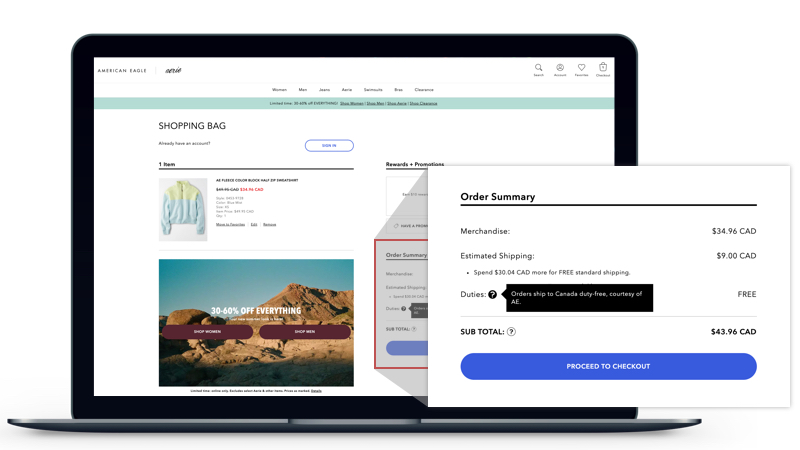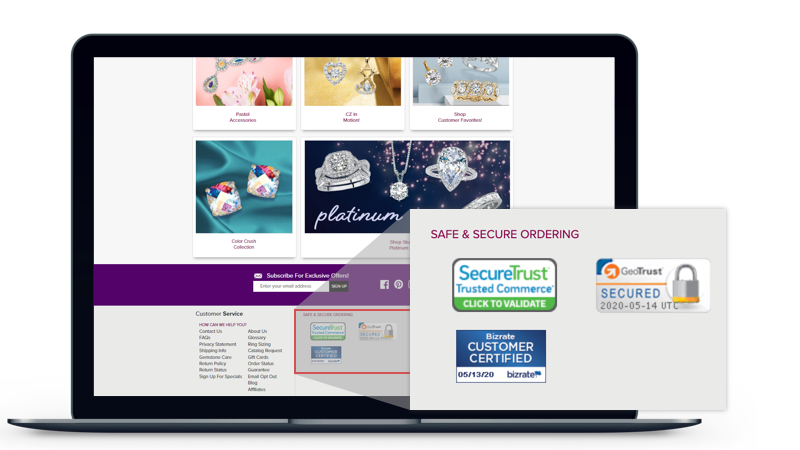Did you know that three out of four Canadian online shoppers abandon their carts during purchase? The checkout cart is one of the key areas in ecommerce that merchants often find puzzling. As a merchant, perhaps you’ve found yourself pondering things like, “Why didn’t that customer complete their order? Their cart has been full for five days now – when are they actually going to make their purchase?”
While it’s impossible to know exactly what goes on inside a customer’s head when they abandon their cart or delay checkout, we do have solid insights into what motivates customers during the checkout phase. With that knowledge in hand, there are ways your business can avoid this disappointing outcome.
Grow your business with Canada Post. We can help you tap into the Canadian ecommerce opportunity.
Contact us5 ways to avoid cart abandonment and boost conversions
Canadians spend more time evaluating shipping costs and delivery times when shopping from American brands. From our studies surrounding Canadian online shoppers, we know these details are a powerful way to boost Canadian conversions. To avoid shopping cart abandonment, here are five tips for achieving better conversion at checkout:
Keep customers informed BEFORE they buy
When it comes to the checkout stage, customers want pertinent delivery information at their fingertips so they can make informed decisions. A key piece of information to include is the delivery date. It’s a major contributing factor to shopping cart abandonment – even more critical than not being able to select a delivery location. In fact, we found that 44 per cent of shoppers will avoid a retailer that doesn’t provide a delivery date.1
 To offer your customers a delivery date at checkout, explore your ecommerce platform’s checkout options. Many of them offer “rating” as a function. Rating enables merchants to display real-time shipping rates and delivery dates for customers before they click the “buy” button. Be sure to take this opportunity to display the name of the shipper as well – withholding that information is another factor that contributes to shopping cart abandonment. It’s important to be as transparent as possible to instill trust at the last stage of the purchasing process.
To offer your customers a delivery date at checkout, explore your ecommerce platform’s checkout options. Many of them offer “rating” as a function. Rating enables merchants to display real-time shipping rates and delivery dates for customers before they click the “buy” button. Be sure to take this opportunity to display the name of the shipper as well – withholding that information is another factor that contributes to shopping cart abandonment. It’s important to be as transparent as possible to instill trust at the last stage of the purchasing process.Tip
If you’re experiencing processing and delivery delays due to the impact of COVID-19, be sure to provide details upfront with shoppers. Let them know that their order may take some additional time to arrive, but that employee safety and customer satisfaction are top of mind when fulfilling orders.
Be transparent about costs
When it comes to making international purchases, accounting for taxes, duties and brokerage fees are thorns in the sides of your customers. You’ll want to try and be as upfront as possible with them to avoid any surprises either within your cart or at their door. This could be as simple as having prices listed in Canadian dollars and making it clear that you ship to Canada, or it might be as easy as being upfront about fees. Be prepared to quickly answer consumer questions about these added charges in your FAQ section to avoid losing the sale.
It’s common practice to give your shoppers the ability to pay these fees in advance. Not having the ability to pay for them in advance has lead almost three quarters of online shoppers to abandon their carts.2 Make sure your customers know the full cost of ordering and receiving your product – regardless of the country they live in. The more transparent you are, the more likely you are to convert browsers into buyers. In fact, 68 per cent of Canadian online shoppers will abandon their cart if these fees are not disclosed upfront.3

American Eagle’s shopping cart page clearly presents all shipping costs upfront.
Keep your return policy clear and concise
Canadians will investigate a merchant’s return policy before they even place an item in their cart – well before they complete the checkout process. They will assess the details of the business’ return policy before they buy, to evaluate whether they would be comfortable making a return should they need to.
It’s important to make your return policy easy to understand and easy to find on your website. And it’s becoming increasingly important to make it as customer friendly as possible. A complicated return policy could cost you your next sale.
To help simplify the experience for both you and your shoppers, Canada Post’s vast network makes it convenient for Canadian shoppers to drop off their returns at one of our 22,000 street letterboxes or our more than 6,000 post office locations.
Highlight safe and secure checkout
Instilling trust is key to turning browsers into buyers. Keep this top of mind as you target and retain new customers.
A first-time buyer living in Canada may not be familiar with your brand. Perhaps they visited your website after seeing an ad on social media. Our research tells us that 46 per cent of online shoppers have visited a retailer website or app after receiving a social media ad.4
At first glance, you’ll want them to know upfront that your ecommerce site is secure and reliable. Ensure that you post information about the security systems you have in place to protect consumer information on your website and especially on your checkout pages. Consumers are more likely to hit the “buy” button if they know a brand is being proactive about safeguarding their data.

Palm Beach Jewelry prominently presents its security certifications on its website.
Follow up with customers who have abandoned their carts
Just because a customer abandons their cart doesn’t mean that they’re gone for good. Implement a cart abandonment strategy to follow up with customers who haven’t completed their purchase. This will help you secure conversions that would otherwise be missed. Big brands like Wayfair Canada enjoy a big impact on conversions by sending direct mail pieces to shoppers that leave carts abandoned. A simple email or direct mail piece that reminds your customers of the items in their abandoned cart could be all that’s needed to incite action. If you’d like to step up your efforts, here are some other strategies worth trying:
Make your copy engaging
Your shopper may have forgotten key messaging on your website between the time they left their cart and received your abandonment email. Think about your value offering and key phrases that can capture the messaging. For example, “It’s not too late,” “Complete now before they sell out,” or “We’ve set this aside for you – but not for long.” FOMO (fear of missing out) is a real thing.
Display your product
Remind them of exactly what they left behind – imagery helps contribute to better brand recall.
Add a call to action
A strong and clear call to action could be the key to increasing your click-through rates. Try testing different wording to see what works with your target audience like “Keep browsing,” “Buy now,” “Complete your purchase,” etc.
Discount codes
Discounts can be highly effective when it comes to improving click rate. Some retailers offer $5 off or 10 per cent off, free shipping and more. Take a look at what works best with your margins and customers.
The big picture
Provide your customers with the best shopping experience possible. Offering a convenient shopping experience that doesn’t leave your customer searching in vain for key shipping information is what you should strive for. It will help you decrease cart abandonment, increase sales and boost your bottom line. This, paired with a positive delivery experience, is what will keep your shoppers coming back for repeat purchases.
Source:
1 Canada Post. 2021 Canadian Online Shopper Study, pg. 21-205, April 2021.
2 Canada Post, 2019 Consumer Study, 19-203, August 2019.
3 Canada Post. 2021 Canadian Online Shopper Study, pg. 21-205, April 2021.
4 Canada Post, 2019 Consumer Study, 19-203, August 2019
We’re here to help.
Contact a Canada Post expert to learn how we can help your business thrive.
Contact an expert